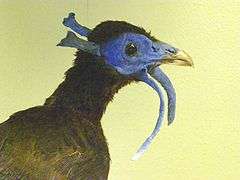Bulwer's pheasant
| Bulwer's pheasant | |
|---|---|
 | |
| Bulwer's pheasant, Lophura bulweri male specimen | |
| Scientific classification | |
| Kingdom: | Animalia |
| Phylum: | Chordata |
| Class: | Aves |
| Order: | Galliformes |
| Family: | Phasianidae |
| Subfamily: | Phasianinae |
| Genus: | Lophura |
| Species: | L. bulweri |
| Binomial name | |
| Lophura bulweri (Sharpe, 1874) | |
| Synonyms | |
|
Lobiophasis bulweri | |
Bulwer's pheasant (Lophura bulweri) is also known as Bulwer's wattled pheasant, the wattled pheasant, or the white-tailed wattled pheasant. It is a Southeast Asian bird in the Phasianidae family; endemic to the forests of Borneo. It is currently listed as Vulnerable by the IUCN.
Description
Bulwer's pheasant is sexually dimorphic. Males have a total length of about 80 centimetres (31 in), and are black-plumaged with a maroon breast, crimson legs, a pure white tail of long, curved feathers, and bright blue facial skin with two wattles that conceal the sides of its head. Females have a total length of about 55 centimetres (22 in), and are an overall dull brown colour with red legs and blue facial skin.
Distribution and habitat
The Bulwer's pheasant is endemic to the island of Borneo.[2] While the species is locally common in protected areas (e.g. Kayan Mentarang National Park, East Kalimantan) it is rarely found elsewhere. The bird inhabits hill and lower montane tropical forest, likely preferring highland rainforests and rarely visiting the lowlands below an altitude of 300 metres (980 ft). The diet consists mainly of fruits, worms, and insects.
Status
Bulwer's pheasant is listed as Vulnerable on the IUCN Red List of Threatened Species due to a rapidly declining population.[1] The primary reasons for this decline are habitat loss and fragmentation due to commercial logging and forest fires. Local hunting is also thought to undermine the birds population. Further, captive breeding programs aimed at preserving the species have met with little success.[3]
Captivity
This species is very rarely kept in zoos. The only western zoo to currently house the species is San Diego Zoo which keeps a pair of these birds. Walsrode Bird Park in Germany has kept the birds as recently as 2003, and Antwerp Zoo, Belgium, has bred the birds. Antwerp Zoo has been very successful with many of the Lophura genus.
Etymology
Bulwer's pheasant belongs to the order Galliformes, in the Phasianidae family. The genus name Lophura is derived from the Greek word lophos for ridge, crest or tuft. The species name bulweri is after Sir Henry Ernest Gascoyne Bulwer, Governor of Labuan 1871-1875, who presented the type specimen to the British Museum.
References
- 1 2 BirdLife International (2013). "Lophura bulweri". IUCN Red List of Threatened Species. Version 2013.2. International Union for Conservation of Nature. Retrieved 26 November 2013.
- ↑ Phillipps, Quentin & Phillipps, Karen (2011). Phillipps’ Field Guide to the Birds of Borneo. Oxford, UK: John Beaufoy Publishing. ISBN 978-1-906780-56-2.
- ↑ Roach J. Vanishing Borneo Pheasants Look Great but Won't Mate National Geographic News. April 2005
